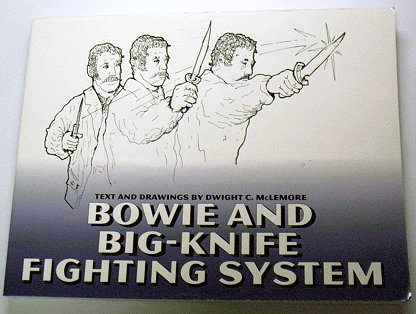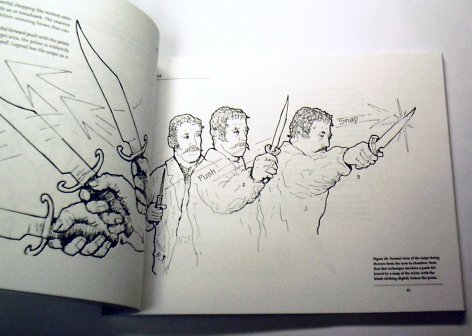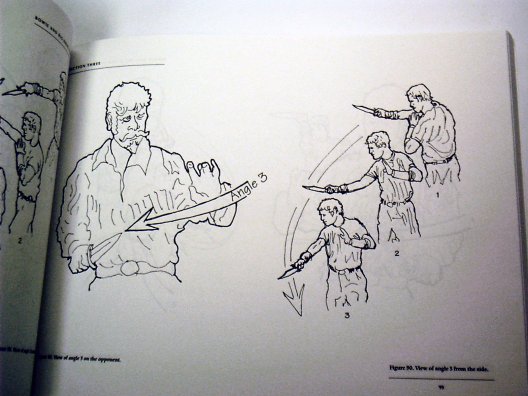its paid sponsors, whose products you need!
“Stay ‘unreasonable.’ If you
don’t like the solutions [available to you], come up with your
own.”
Dan Webre
The Martialist does not
constitute legal advice. It is for ENTERTAINMENT
PURPOSES ONLY.
Copyright © 2003-2004 Phil Elmore, all rights
reserved.
Bowie and Big Knife Fighting System
A Book Review by Phil Elmore

One of my favorite true stories is that of Wisconsin
Republican John Fox Potter. A sarcastic and witty man who ardently
opposed slavery, Potter was accused of inserting further remarks into the
official record after a heated abolition debate in 1860. Virginia
congressman Roger Pryor, incensed over this, challenged Potter to a duel.
Potter accepted and, as the challenged party, stipulated Bowie knives of equal
size, weight, and length. Some accounts state that he went on to demand
that the duel be held in a darkened room, the duelists lashed together by one
arm each.
Pryor backed down in the face of such a duel. For the
rest of his life, Potter was known as “Bowie Knife” Potter. Fans across
the country sent him knives of all sizes, the largest a seven-foot
presentation piece reportedly inscribed with the slogan, “I will always keep a
Pryor engagement.”
Potter tripped over his pet cat in 1899 and died from
injuries sustained in the fall.
We need more political leaders willing to duel each other.
It might cut down on the red tape in Washington. If Pryor and Potter
were alive today, they’d have something to which neither of them had access in
the 19th century: a thick, coloring-book-sized duelist’s manual written by
Dwight McLemore. Government functionaries contemplating the search for
satisfaction on the Field of Honor would be well-served to tuck copies of this
book into their briefcases.
Beautifully illustrated with drawings done by McLemore from
photographs, Bowie and Big-Knife Fighting System is a 225-page
softcover text published by
Paladin Press.
McLemore, a retired combat arms officer with the U.S. Army and a blade
instructor of some renown, makes no claims to have discovered or uncovered
some official and historically accurate Jim Bowie Fighting Style.
Rather, he has applied his considerable research on the topic of Bowies and
large-blade fighting to produce or reconstruct a system employing the methods
and principles common to large-knife fighting across cultures. Drawing
heavily from Renaissance fencing and Western historical documentation,
McLemore describes a style of fighting with big knives that presumes a dueling
format. That is, we are fighting in the context of two similarly armed
opponents.

This is an excellent book for anyone interested in large
knives in general and Bowie knives in particular. It is visually
pleasing and rich with information. Regardless of your opinion of
the style espoused by McLemore, the book is a triumph of applied research.
After providing some historical analysis of Jim Bowie and
his fabled knife (or knives), McLemore discusses large knife composition,
advocates wooden training knives, and depicts saber, “universal,” and foil
grips. Several different stances are described and illustrated, ranging
from “Spanish” and “Italian” stances to the “Biddle” and “Styers” stances.
One nice feature of these descriptions is top-down look at the foot placement
for each, as well as brief discussions of the stances’ key aspects.
After discussing stance and the principles of selecting a
good one, McLemore describes different guards and means of “presenting the
blade.” A lengthy section is devoted entirely to the thrust, including
movement, target, and specific thrusting techniques. This is followed by
a section on cutting, which includes multiple descriptions of the “back cut”
and an eight-angle cutting system with obvious similarities to the Filipino
Martial Arts. Parries and counters are also included.
Throughout the book, McLemore’s captivating illustrations
and helpful diagrams bring his words to life. I honestly considered
breaking out a box of crayons and coloring in each illustration neatly, so
clean and inviting are the drawings.

The next-to-last section of the book is titled “The Forever
Principles,” comprised of “a loose conglomeration of concepts and techniques
that have prevailed as constants throughout the history of bladework.” These
include discussions of range, footwork and movement, angling, and other
physical and mental concerns. The last section of the book is a
“portfolio of techniques, drills, and training notes.” The book also
contains an extensive bibliography.
This is a book that must be seen and enjoyed to be
appreciated. There is much of value here, but the real innovation is in
the artistic presentation. Not really “formal” but eminently
professional, Bowie and Big Knife Fighting System is truly a pleasure
to read.
Buy your copy now, before the next elections.
